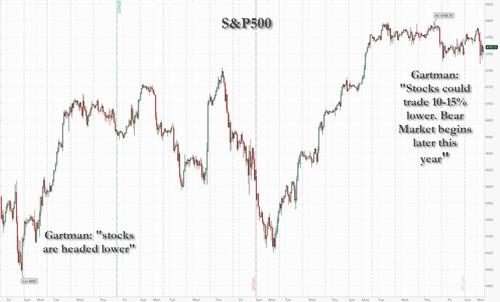While “we are definitely in the middle of a very severe surge” in COVID-19 infections, President Joe Biden’s chief medical adviser said yesterday, “we have not seen a concomitant increase” in hospitalizations. Recent numbers show “almost a vertical increase” in newly identified cases, Anthony Fauci noted on ABC’s This Week. But as “infections become less severe,” he said, “it is much more relevant to focus on the hospitalizations as opposed to the total number of cases.”
Fauci is surely right that focusing on case numbers rather than severe disease is more misleading than ever. But while hospitalizations are a better indicator of severe disease, those numbers also can be misleading, because they include relatively mild cases and people who tested positive for the coronavirus after they were admitted for different reasons.
The evidence so far, including data from the U.K. published last Friday, indicates that the omicron variant, which accounts for an estimated 59 percent of current COVID-19 cases in the U.S., is more contagious but less lethal than the delta variant. And while there is ample reason to worry that the sheer number of COVID-19 cases will overwhelm hospitals, the current situation is far less dire than what we saw last winter.
According to the New York Times database, the seven-day average of newly identified cases in the United States tripled during the last two weeks. Those data surely understate the actual number of infections, since results from rapid home tests are not necessarily reported and (as usual) many people with mild or no symptoms do not get tested at all. But during the same period that reported cases rose by 204 percent, hospitalizations rose by just 35 percent, and deaths declined by 3 percent. The latter development is especially striking because the current surge in U.S. cases began about a month ago.
The seven-day average of daily new cases, according to the Times, was more than 400,000 as of yesterday, which is 61 percent higher than the peak during last winter’s surge. Yet the seven-day average of daily deaths was less than 1,300, compared to 2,600 a year before and more than 3,300 in mid-January 2021. The seven-day average for hospitalizations was about 93,000, compared to about 131,000 a year before and about 138,000 on January 10, 2021.
It is not clear how many of those hospitalizations involved incidental or mild infections, as opposed to life-threatening symptoms. But according to a study of patients admitted to V.A. hospitals in the period from March 1, 2020, to June 30, 2021, the share of admissions involving moderate-to-severe COVID-19 cases fell from 64 percent before vaccines were widely available to 52 percent afterward.
“Routine inpatient screening, common or mandated in many facilities, may identify incidental cases,” the researchers noted. “If hospitalizations are used as a metric for policy decision-making, patients hospitalized for the management of COVID-19 disease should be distinguished from patients who are hospitalized and incidentally found to be infected with SARS-CoV-2.”
Chris Hopson, CEO of NHS Providers, which represents British health care workers, made a similar point in a Twitter thread last week. Here is how he summarized his conversations with the heads of the trusts that oversee British hospitals: “What’s very interesting is how many are talking about [the] number of asymptomatic patients being admitted to hospital for other reasons and then testing positive for Covid. Some are describing this as ‘incidental Covid.'” Hopson wrote that hospitals are “not, at [the] moment, reporting large numbers of patients with severe Covid type respiratory problems needing critical care.”
Studies of pediatric admissions also have found that mild or incidental cases accounted for a large share of so-called COVID-19 hospitalizations. In one study, two-fifths of admissions to a California children’s hospital from May 10, 2020, to February 10, 2021, involved patients who were asymptomatic. One-fifth involved “severe” or “critical” cases.
In another study, 40 percent of COVID-positive pediatric patients admitted in the period from May 1, 2020, to September 30, 2020, had “incidental infection,” 47 percent were “potentially symptomatic,” and the rest were “significantly symptomatic.” In this age group, the researchers reported, “most hospitalized patients who test positive for SARS-CoV-2 are asymptomatic or have a reason for hospitalization other than coronavirus disease 2019.”
While pediatric admissions are rising during the current surge, the Times reported last week, “doctors and researchers said they were not seeing evidence that Omicron was more threatening to children.” To the contrary, “preliminary data suggests that compared with the Delta variant, Omicron appears to be causing milder illness in children, similar to early findings for adults.”
Those early findings include studies from South Africa and Scotland that found omicron was less likely than other variants to cause life-threatening symptoms. Between October 1 and December 6, according to the South African study, COVID-19 patients infected by omicron were 80 percent less likely to be hospitalized than patients infected by other variants. The same study found that patients infected by the omicron variant who were admitted to hospitals this fall were 70 percent less likely to develop severe disease than patients infected by the delta variant who were hospitalized between April and November. According to the Scottish study, “Omicron is associated with a two-thirds reduction in the risk of COVID-19 hospitalisation when compared to Delta.”
A report that the U.K. Health Security Agency released on Friday reinforces those findings. According to a study of hospital patients, “the risk of presentation to emergency care or hospital admission with Omicron was approximately half of that for Delta,” and “the risk of hospital admission from emergency departments with Omicron was approximately one-third of that for Delta.”
That study also found that the risk of hospitalization was 81 percent lower among omicron patients who had received three vaccine doses than it was among unvaccinated omicron patients. A second study looked at symptomatic cases diagnosed in the community. While it confirmed that vaccination was less effective at preventing symptomatic infection by omicron than it was at preventing symptomatic infection by delta, omicron patients who had received three doses were still 68 percent less likely to be hospitalized than unvaccinated omicron patients.
Data from the Centers for Disease Control and Prevention (CDC) indicate that severe cases as a share of “COVID-19-associated hospital admissions” peaked in the spring of 2020. That March, about 38 percent of patients required intensive care and 27 percent needed mechanical ventilation. In-hospital fatalities peaked that April, when 17 percent of admitted COVID-19 patients died. As of September, the most recent month for which the CDC is reporting detailed data, 21 percent of hospitalized COVID-19 patients received intensive care, 11 percent received mechanical ventilation, and 12 percent died in the hospital. Now that omicron is displacing delta and most of the population has been vaccinated and/or acquired some protection as a result of prior infection, the downward trend in severe outcomes as a percentage of admissions is likely to continue.
Even so, the explosion in cases is overwhelming some health care systems, which threatens treatment not only for COVID-19 but also for other potentially deadly medical conditions. Hospitalizations are still rising, which will cause serious problems during the next few weeks. “You’re still going to get a lot of people that are going to be needing hospitalization,” Fauci noted on This Week. “And that’s the reason why we’re concerned about stressing and straining the hospital system.”
But as Fauci also noted, it seems likely that “this thing will peak after a period of a few weeks and turn around.” That is what happened in South Africa, where the omicron variant was first identified in November. The seven-day average of daily new cases in South Africa exploded from mid-November to December 18 but has fallen sharply since then. “They had a major surge,” Fauci noted, “but as quickly as the surge went up, it turned around.” And as in the United States and the U.K., the increase in deaths, which even at their peak remained far below the numbers reported last January, was much smaller than the increase in cases.
“The emerging evidence suggests that Omicron really is milder than earlier versions of this coronavirus (either because of intrinsic biological reasons or because of higher levels of population immunity),” David Leonhardt and Ashley Wu write in the Times. “In South Africa and England, as well as New York, San Francisco and other parts of the U.S., hospitalization numbers are lower than doctors had feared.”
Leonhardt and Wu suggest that “when the current surge begins receding, it will likely have left a couple of silver linings.” They note that omicron’s high transmissibility will increase natural immunity. Research in South Africa suggests that omicron infection dramatically boosts resistance to delta, which is especially good news because it seems the latter variant is more likely to cause severe disease. Omicron “has also helped focus Americans on the importance of booster shots, further increasing immunity,” Leonhardt and Wu say. They add that new COVID-19 treatments from Pfizer and Merck “lower the risk of hospitalization and death” by as much as 90 percent.
In short, Leonhardt and Wu say, “the U.S. could emerge from the Omicron wave significantly closer to the only plausible long-term future for Covid—one in which it becomes an endemic disease and a more normal part of daily life.” While “it will still cause illness and death,” COVID-19 as an endemic disease “does not need to dominate life the way a pandemic does,” they note. “If the U.S. reaches that point in 2022—as appears likely—the next New Year will feel a lot more satisfying than this one.”
The post Anthony Fauci Is Right To Distinguish COVID-19 Infections, Which Are Exploding, From Severe Disease, Which Is Not appeared first on Reason.com.
from Latest – Reason.com https://ift.tt/3pP0qfO
via IFTTT








